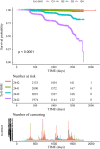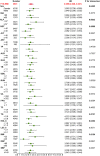Association between triglyceride glucose-body mass index and non-alcoholic fatty liver disease in the non-obese Chinese population with normal blood lipid levels: a secondary analysis based on a prospective cohort study
- PMID: 33109219
- PMCID: PMC7592551
- DOI: 10.1186/s12944-020-01409-1
Association between triglyceride glucose-body mass index and non-alcoholic fatty liver disease in the non-obese Chinese population with normal blood lipid levels: a secondary analysis based on a prospective cohort study
Abstract
Background: Both triglyceride glucose-body mass index (TyG-BMI) and non-alcoholic fatty liver disease (NAFLD) are linked to insulin resistance (IR). Prospective studies linking TyG-BMI to NAFLD have been limited by short follow-up. This study investigated the longitudinal association between TyG-BMI and NAFLD occurrence in the non-obese Chinese individuals.
Methods: This study determined TyG-BMI at baseline and the incidence of NAFLD at follow-up and performed a post hoc analysis of a prospective cohort study that involved assessing the risk of NAFLD in non-obese Chinese residents from January 2010 to December 2014. The incidence of NAFLD during the 5-year follow-up was identified as the endpoint. Cox proportional hazards regression analysis was used to evaluate hazard ratios (HRs) and 95% confidence intervals (95% CIs) for the incidence of NAFLD. Receiver operating characteristic (ROC) curve analysis was conducted to estimate the predictive power of TyG-BMI and its components for NAFLD. Subgroup analysis was performed to better understand other factors that may affect the association between TyG-BMI and NAFLD to identify potential special populations.
Results: During the follow-up period, 841 (8.61%) of 9767 non-obese subjects who met the screening criteria were diagnosed with NAFLD. After confounding factors were fully adjusted for, the HR of NAFLD was 3.09 (95% CI 2.63-3.63) per standard deviation (SD) increase in TyG-BMI. Furthermore, TyG-BMI had a strong predictive value (area under ROC = 0.85; 95% CI 0.84-0.86) for the incidence of NAFLD, with a specificity of 0.73 and sensitivity of 0.82. Additionally, in the male population, each SD increase in TyG-BMI was linked to an increased risk of NAFLD (HR = 2.85, 95% CI 2.30-3.53), but the risk was higher in the female population (HR = 3.58, 95% CI 2.80-4.60). Gender and TyG-BMI interacted significantly with NAFLD incidence (P < 0.0001).
Conclusion: In the normolipidaemic and non-obese subset of the Chinese population, an increase in TyG-BMI is related to an increased incidence of NAFLD. TyG-BMI may have clinical significance in identifying groups at high risk of NAFLD.
Keywords: Association; Body mass index; Fasting plasma glucose; Insulin resistance; Non-alcoholic fatty liver disease; Secondary analysis; Triglyceride; Triglyceride glucose body mass index.
Conflict of interest statement
No conflicts of interest.
Figures




Similar articles
-
The triglyceride glucose-body mass index: a non-invasive index that identifies non-alcoholic fatty liver disease in the general Japanese population.J Transl Med. 2022 Sep 5;20(1):398. doi: 10.1186/s12967-022-03611-4. J Transl Med. 2022. PMID: 36064712 Free PMC article.
-
[Triglyceride-glucose index in non-obese individuals: its association with and predictive value for non-alcoholic fatty liver disease].Nan Fang Yi Ke Da Xue Xue Bao. 2024 Jul 20;44(7):1266-1271. doi: 10.12122/j.issn.1673-4254.2024.07.06. Nan Fang Yi Ke Da Xue Xue Bao. 2024. PMID: 39051072 Free PMC article. Chinese.
-
Value of triglyceride glucose-body mass index in predicting nonalcoholic fatty liver disease in individuals with type 2 diabetes mellitus.Front Endocrinol (Lausanne). 2025 Jan 20;15:1425024. doi: 10.3389/fendo.2024.1425024. eCollection 2024. Front Endocrinol (Lausanne). 2025. PMID: 39902164 Free PMC article.
-
Triglyceride glucose waist circumference and non alcoholic fatty liver disease: a systematic review and meta analysis.BMC Gastroenterol. 2025 May 1;25(1):328. doi: 10.1186/s12876-025-03888-x. BMC Gastroenterol. 2025. PMID: 40312323 Free PMC article.
-
The triglyceride and glucose index and risk of nonalcoholic fatty liver disease: A dose-response meta-analysis.Front Endocrinol (Lausanne). 2023 Jan 19;13:1043169. doi: 10.3389/fendo.2022.1043169. eCollection 2022. Front Endocrinol (Lausanne). 2023. PMID: 36743937 Free PMC article.
Cited by
-
The atherogenic index of plasma: A novel factor more closely related to non-alcoholic fatty liver disease than other lipid parameters in adults.Front Nutr. 2022 Sep 2;9:954219. doi: 10.3389/fnut.2022.954219. eCollection 2022. Front Nutr. 2022. PMID: 36118762 Free PMC article.
-
The triglyceride glucose-body mass index: a non-invasive index that identifies non-alcoholic fatty liver disease in the general Japanese population.J Transl Med. 2022 Sep 5;20(1):398. doi: 10.1186/s12967-022-03611-4. J Transl Med. 2022. PMID: 36064712 Free PMC article.
-
Association between the cumulative average triglyceride glucose-body mass index and cardiovascular disease incidence among the middle-aged and older population: a prospective nationwide cohort study in China.Cardiovasc Diabetol. 2024 Jan 6;23(1):16. doi: 10.1186/s12933-023-02114-w. Cardiovasc Diabetol. 2024. PMID: 38184577 Free PMC article.
-
Comparison of obesity-related indices for identifying nonalcoholic fatty liver disease: a population-based cross-sectional study in China.Lipids Health Dis. 2021 Oct 10;20(1):132. doi: 10.1186/s12944-021-01560-3. Lipids Health Dis. 2021. PMID: 34629056 Free PMC article.
-
Comparison of the diagnostic value between triglyceride-glucose index and triglyceride to high-density lipoprotein cholesterol ratio in metabolic-associated fatty liver disease patients: a retrospective cross-sectional study.Lipids Health Dis. 2022 Jun 25;21(1):55. doi: 10.1186/s12944-022-01661-7. Lipids Health Dis. 2022. PMID: 35752830 Free PMC article.
References
-
- Younossi ZM, Koenig AB, Abdelatif D, Fazel Y, Henry L, Wymer M. Global epidemiology of nonalcoholic fatty liver disease-meta-analytic assessment of prevalence, incidence, and outcomes. Hepatology. 2016;64:73–84. - PubMed
-
- Khashab MA, Liangpunsakul S, Chalasani N. Nonalcoholic fatty liver disease as a component of the metabolic syndrome. Curr Gastroenterol Rep. 2008;10:73–80. - PubMed
-
- Xia C, Li R, Zhang S, Gong L, Ren W, Wang Z, Li Q. Lipid accumulation product is a powerful index for recognizing insulin resistance in non-diabetic individuals. Eur J Clin Nutr. 2012;66:1035–1038. - PubMed
-
- Kim NH, Kim JH, Kim YJ, Yoo HJ, Kim HY, Seo JA, Kim NH, Choi KM, Baik SH, Choi DS, Kim SG. Clinical and metabolic factors associated with development and regression of nonalcoholic fatty liver disease in nonobese subjects. Liver Int. 2014;34:604–611. - PubMed
MeSH terms
Substances
LinkOut - more resources
Full Text Sources
Medical
Miscellaneous

